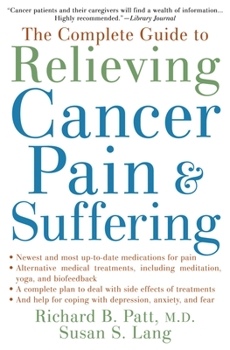The Complete Guide to Relieving Cancer Pain and Suffering
Select Format
Select Condition 
Book Overview
Most cancer patients fear unremitting pain more than the prospect of an untimely death, and are surprised to learn that most of the pain and related symptoms of cancer can be successfully addressed by an informed patient working with a determined health care team.
Thoroughly updating their widely praised 1994 book, You Don't Have to Suffer, Dr. Richard B. Patt and Susan Lang offer a much-needed handbook for patients and caregivers on all aspects...
Format:Paperback
Language:English
ISBN:0195312023
ISBN13:9780195312027
Release Date:December 2006
Publisher:Oxford University Press, USA
Length:464 Pages
Weight:1.45 lbs.
Dimensions:1.2" x 5.6" x 9.8"
Customer Reviews
2 ratings
Complete Guide for Relieving Cancer Pain by Patt et al.
Published by Thriftbooks.com User , 18 years ago
The author cites classic reasons why chronic pain may be undertreated by medical providers. These reasons include: - inadequate training of medical staff - concerns and unfounded fears about addiction - some providers believe that pain should be severe before a treatment option is selected The author distinguishes between physical dependence and addiction. Physical dependence may precipitate a feeling of illness once the drug is stopped. Addiction refers to a psychological longing or dependence on the drug. Patients have a right to report pain and expect that medical providers will believe the critical incidences reported by the patients. Treatment is a right which flows from the medical provider's understanding of the medical history and appreciation for the pain sensations reported. Classic cancer warnings are increased bladder or bowel movements, chronic swallowing problems, unexplained lethargy, persistent infections, unhealed sores, shortness of breath or hoarseness. A pain inventory may consist of the following: - diagram of the pain - description of the worst incidences - interference with activity - sleep interference - decreased energy Most health care treatments are geared toward curative therapies. The World Health Organization has stated that " In short, the right drug at the right dose given at the right time relieves 80% to 90% of pain." WHO: Cancer Pain and Palliative Care- A Technical Report Series 804 of WHO 1990 and 1996 Revised This work discusses classic pain modalities; such as, TENS and drug choices for chronic pain. It is a solid value for the price charged.
Publisher's Weekly review of previous edition
Published by Thriftbooks.com User , 19 years ago
From Publishers Weekly For the millions of Americans who will be diagnosed with cancer, Lang, a Cornell University science writer, and Patt, the deputy chief of the Pain Service at Houston's M.D. Anderson Cancer Center, have written a handbook for those seeking respite from cancer pain. It is estimated that relief can be achieved in 90 to 99 percent of cancer patients if the correct treatments are applied. This book, clearly written for the consumer, is intended for anyone who has cancer or is caring for a loved one with the disease, as well as for the professionals who treat patients and their families. Lang and Patt examine the physiology of cancer pain and how not fighting it can get in the way of healing. Among the reasons the authors cite for why cancer patients are undermedicated for pain: doctors are not well-informed about pain medication and dosage, and fear that patients will become addicted to pain relievers; patients feel they must tough it out. The book also explores our culture's fear of narcotics, one of the cornerstones in the treatment of moderate to severe cancer pain. By exploring all of the pain-relieving options available--from over-the-counter drugs and high-tech medical techniques to home nursing tips to make patients more comfortable--it enables cancer patients to make informed decisions about their care and offers them a way to improve the quality of their lives. Copyright 1993 Reed Business Information, Inc.--This text refers to an out of print or unavailable edition of this title. From Library Journal Every year one million Americans are diagnosed with cancer and must endure the pain that often accompanies it. Patt, one of the country's leading cancer pain experts, has teamed up with science writer Lang to produce a sensible, much-needed handbook for patients and caregivers on aspects of cancer pain. Undermedication is one of the primary problems; this stops many patients from resuming active lives and having the strength to fight their disease. The authors explore options--drugs, high-tech medical procedures, psychological techniques, and home nursing tips--to help relieve pain and give comfort. Fears of addiction are addressed, as is the "stiff upper lip" syndrome. Medications for accompanying health problems are also discussed. Recommended. See also Jane Cowles's Pain Relief!: How To Say "No" to Acute, Chronic, and Cancer Pain , LJ 11/1/93.--Ed. - Janet M. Coggan, Univ. of Florida Libs., Gainesville Copyright 1993 Reed Business Information, Inc.--This text refers to an out of print or unavailable edition of this title. Product Description: On March 2, 1994, the Agency for Health Care Policy and Research (a division of the Public Health Service) made headlines by releasing new cancer pain management guidelines. That report revealed that pain is frequently undertreated, and that relief is not only possible for most patients, but actually aids in recovery. For many cancer victims, the agency's guidelines offered new h




